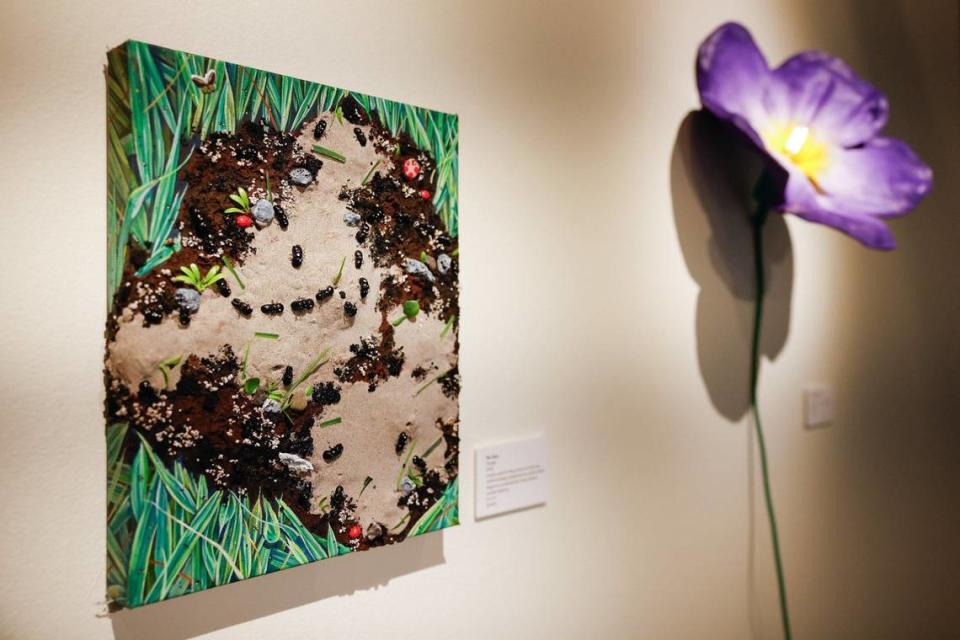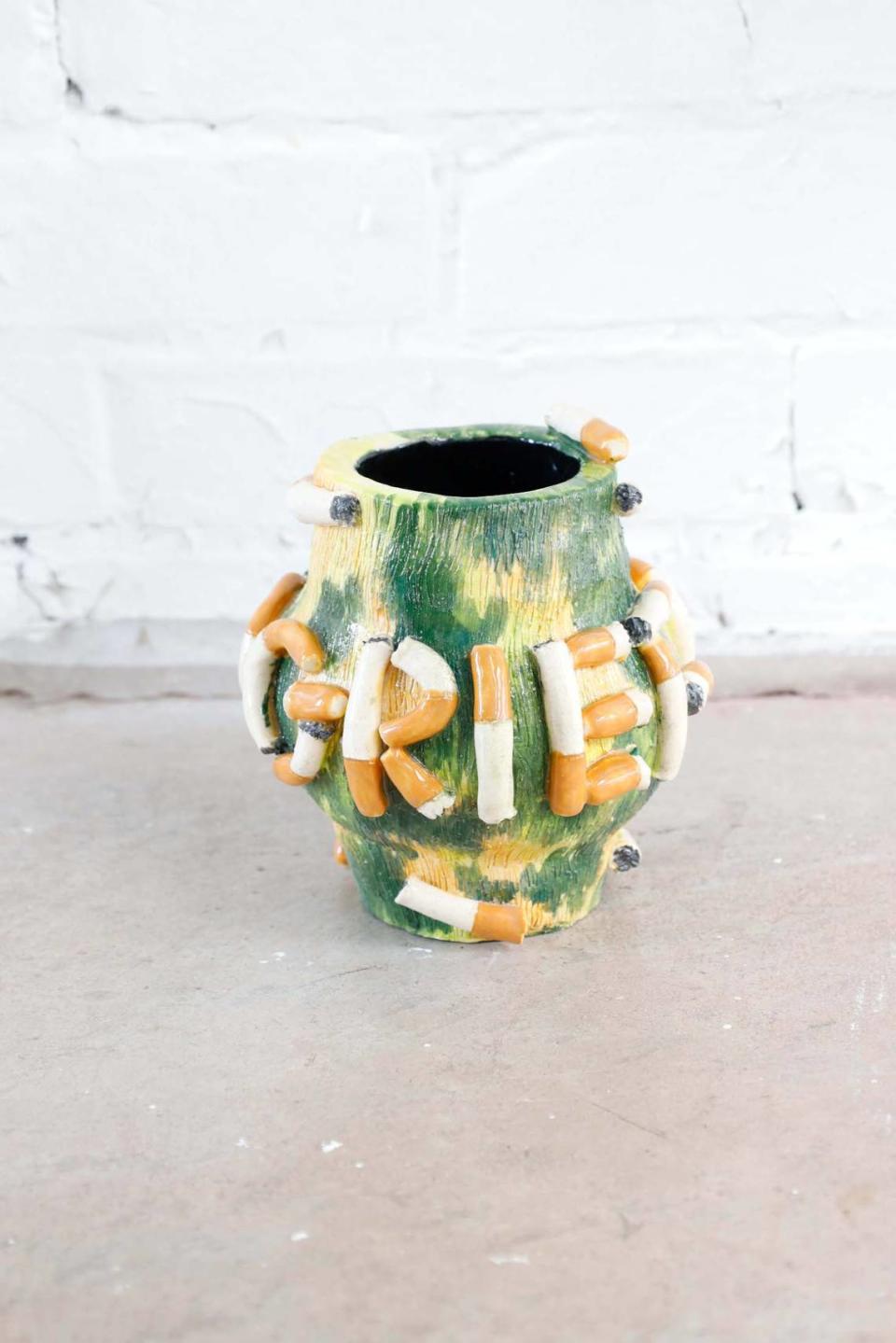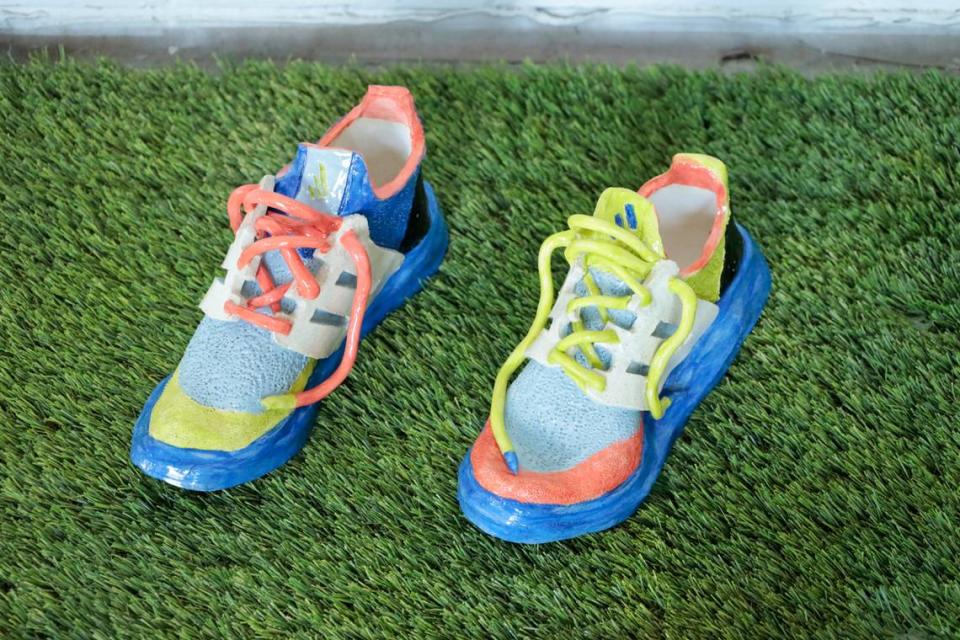This Charlotte artist cheerfully works with ‘garbage’ to challenge expectations
Charlotte-based Taylor Lee Nicholson is a multidisciplinary artist whose work defies easy categorization.
The non-binary creative, who uses they/them pronouns, produces a variety of work — from floral clay-based sculptures that recall Lladro to Swarovski encrusted pieces that are reminiscent of Judith Liebler miniatures. But their work is all their own.
And Nicholson served as curator for the latest exhibit at the McColl Center, “American Honey,” which opened Aug. 10. It features “the work of 10 artists, all queer, who are working with the broader theme of Americana, but through a queer and trans lens,” the center said.
The exhibit also was timed to coincide with Charlotte’s annual Pride Festival and Parade this weekend.
Nicholson’s own work is eye-catching, upbeat and cheerful on the surface. It recalls Americana kitsch and spotlights objects often considered lowbrow, such as beer cans, cigarette butts and trucker hats. But the subject matter is intended to challenge the viewer to consider what lies beneath the superficial.
As Nicholson explained, it should serve as a commentary on American life and society.
“What are the things we value? What are the things we discard or destroy? What are the things we consume?” Nicholson asked. “My work asks the viewer to respond to those questions. And the answers are often uncomfortable.”
To that end, a recurring theme in the artist’s work is that of “garbage” — which their creative statement explicitly evokes and they reaffirmed during a recent interview with The Charlotte Observer.
“I embrace trash as both subject and material — to highlight the grotesque beneath the veneer,” Nicholson said.
This complex approach to art is informed by the artist’s upbringing in eastern North Carolina and their formal education. That included an undergraduate degree in literature and history from UNC Chapel Hill and an MA in painting from the Savannah College of Art and Design.

“My work is meant to cause the viewer to pause and consider some of the deeper issues in society.” Another goal, said Nicholson, is to “compel people towards acts of social justice.”
Garbage, as Nicholson described it, is the “unbecoming” element of society. And they said they consumed a steady diet of “garbage” from an early age, from junk food to tabloids and reality TV shows like “Jerry Springer” and “Maury Povich.”
Their early creative efforts were realized through compositions made from found objects, since, as Nicholson noted, “there wasn’t extra money for art supplies or art classes and tutors.”
Instead, an early introduction to creative production through art therapy prompted them to generate three-dimensional works through compilations of cast-off items like discarded Splenda packets and other ephemera. While some might see the garbage as distraction, this has been the lens through which Nicholson has found clarity to express their artistic vision.
For instance, a current series of ceramic urns engages with a variety of subjects like mental health and divorce.

Removing their mask
When asked about the reception of their art, Nicholson paused for a moment.
“You know how people talk about the idea of masking, that is, making yourself palatable for others? Well, throughout my early education and beyond, I was taught that it was good to be patient, to be a good student, not to push back.”
Once they started challenging the status quo, however, their art blossomed. And the reception from their peers has been nothing but supportive.
Nicholson credited the community they have built at the McColl Center with being transformative as it has allowed their creativity to flourish and “to really be seen as an artist without the mask,” they said.
In fact, one collaboration last year brought the Charlotte-based art installation “YARD SALE” to Los Angeles to participate in the “Spring Break Art Show.”
This installation, co-curated by Janet Loren Hill and Jonell Logan, leaned into the hallmarks of Nicholson’s aesthetic. That involved presenting intricately beaded vintage tabloid covers, a bird bath of discarded ceramic cigarette butts, papier-mache hot dogs and flamingo lawn art.
Even the wall tiles of the installation were created from “trash,” like old credit card statements, sale coupons and debt relief offered as a commentary on American consumerism and consumption culture.
As Nicholson described it, the installation also had a participatory element inherent in its design. Art collectors purchasing work from the show ultimately were aiding in its deterioration — which is an overarching theme in their work.
Projects like these have garnered national recognition for an approach to creating that is organic, even as the artist generates work out of man-made, mass-produced cast-offs–rather than material from nature. In doing so, they suggest that the infinite resource of material may well be the very things that we try to discard.

Inspiring the next generation of creatives
As much as Nicholson derives creative inspiration from being part of a larger artistic community, they noted that they “place less emphasis on what I can do as an individual and more on what I can do with others. To that end, one of the projects they are most excited about are their workshops with young people.
“(The kids) are really earnest,” they said. “And they are so excited about making art.
“I’ve been teaching a sculpture camp. And instead of doing the usual, like let’s make some sunflowers inspired by Van Gogh, I’m introducing them to different contemporary artists like Lorien Stern, who makes these cool ceramic shark heads and then they make their own. I mean, what’s more fun than that?,” they said with a laugh.
Nicholson hopes to grow these efforts into the production of mini-exhibitions that can scale and teach young people how to curate and produce a show.

Current work and what’s next
“American Honey,” runs through Sept. 15 at the McColl.
Paul Maloney, who creates ceramic vessels, Marianna Peragallo who makes sculptures out of Thank You bags and Cassidy Early, whose paintings celebrate the queer body, are among the artists whose work is on display.
Nicholson hopes that their self-described “choosy curation” will resonate with visitors who will appreciate its welcoming and community-focused environment.

Nicholson is now working on their next exhibition, called “Born To Run.” They described it as a meditation on divorce that is “quieter, and more reflective” than some of their previous work.
The show will feature pieces in a variety of media.
And when asked if the show’s title is meant to deliver a dual message, one of escape (from a marriage) while also alluding to the author of the classic American anthem himself, Bruce Springsteen, Nicholson just smiled.
More arts coverage
Want to see more stories like this? Sign up here for our free “Inside Charlotte Arts” newsletter: charlotteobserver.com/newsletters. And you can join our Facebook group, “Inside Charlotte Arts,” by going here: facebook.com/groups/insidecharlottearts.


